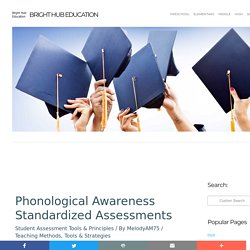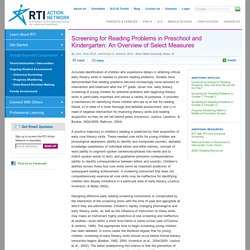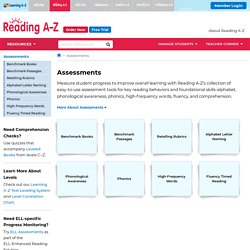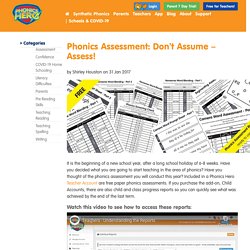

Child Development Charts - Kid Sense Child Development. Handout6 QPAS. Download Assessments and Resources. Phonological Awareness Standardized Assessments. Phonological Awareness Children need phonological awareness in order to learn to read.

Children with phonological awareness have the ability to break oral language down into smaller units and to manipulate sounds. For example, sentences can be broken down into words, words can be broken down into syllables and syllables can be broken down into phonemes or individual sounds. Manipulating sounds involves substituting one sound for another, deleting sounds and adding sounds. Phonological Awareness Assessment. Phonological Awareness: Instructional and Assessment Guidelines.
This article defines phonological awareness and discusses historic and contemporary research findings regarding its relation to early reading.

Common misconceptions about phonological awareness are addressed. Phonological Awareness Assessment: A Foundational Reading Skills Diagnostic Tool. This diagnostic assessment will help you determine exactly which foundational reading skills your emerging readers have under control and which ones they don't.

This assessment is designed to assess 16 different phonological awareness skills from most foundational (easiest) to the least foundational (more difficult) covering skills in the Kindergarten and First Grade Reading Foundational Skills standards. Phonological awareness skills are essential for reading development as students become proficient in manipulating sounds auditorily, they become better able to recognize familiar and predicable speech and language patterns when reading orally.
This assessment, which I also like to call a "digger deeper assessment" can be used after universal screening to determine an appropriate foundational reading intervention in the area of phonological awareness. Thank You! Jen & Kathi Hello Two Peas in a Pod. Speech Sound Disorders: Articulation and Phonology: Assessment. See the Assessment section of the Speech Sound Disorders Evidence Map for pertinent scientific evidence, expert opinion, and client/caregiver perspective.

Screening Screening is conducted whenever a speech sound disorder is suspected or as part of a comprehensive speech and language evaluation for a child with communication concerns. The purpose of the screening is to identify individuals who require further speech-language assessment and/or referral for other professional services. Screening typically includes screening of individual speech sounds in single words and in connected speech (using formal and or informal screening measures);screening of oral motor functioning (e.g., strength and range of motion of oral musculature); orofacial examination to assess facial symmetry and identify possible structural bases for speech sound disorders (e.g., submucous cleft palate, malocclusion, ankyloglossia); andinformal assessment of language comprehension and production.
Phonological Awareness Screening Informal Assessment {Phonics Reading Tools} The following phonological awareness screening tools can be found in this instrument: rhyme identification, rhyme production, sentence segmentation, syllable segmentation, blending, deletion, initial isolation of sounds, medial isolation of sounds, final isolation of sounds, letter sound identification, short and long vowel identification plus informal assessments are included.

Use the screening tool to determine which areas the student has difficulty in. Document the results of the screening on page two. If they should have a skill but do not, then use the coordinating informal assessment. Use the pretest as a baseline assessment, drill the skills the child needs, and then reassess to determine growth in that area. Phonemic Awareness Assessment. All assessments should be given one-on-one.

When should it be assessed? Phonemic awareness assessments should be done three times during the kindergarten and first grade years to help guide instruction. Examples of assessment questions * Remember, when a letter appears between slash marks, you should say the letter sound, and not the letter name. Phoneme matching Which words sound alike? Assessment Instrument Description: PALS. Screening for Reading Problems in Preschool and Kindergarten. By Juli L.

Pool, Ph.D., and Evelyn S. Johnson, Ed.D., Boise State University, Boise, ID Accurate identification of children who experience delays in attaining critical early literacy skills is needed to prevent reading problems. Studies have demonstrated that reading problems become increasingly more resistant to intervention and treatment after the 3rd grade. Assessments. Measure student progress to improve overall learning with Reading A-Z's collection of easy-to-use assessment tools for key reading behaviors and foundational skills-alphabet, phonological awareness, phonics, high-frequency words, fluency, and comprehension.

More About Assessments Why Use Assessments Assessments help you identify areas of instruction to meet every student's individual needs. Foundational skills require mastery before students can become fluent readers and comprehend what they are reading. Identifying key foundational skills and complex reading behaviors with assessments helps you focus your instructional time on concepts students struggle to understand. pose. Phonological Awareness Assessment and ... Identifying Preschool Children At-Risk of Later Reading Difficulties: Evaluation of two Emergent Literacy Screening Tools. Phonics Assessment: Don't Assume - Assess Every Student! By Shirley Houston on 31 Jan 2017 It is the beginning of a new school year, after a long school holiday of 6-8 weeks.

Have you decided what you are going to start teaching in the area of phonics? Have you thought of the phonics assessment you will conduct this year? Included in a Phonics Hero Teacher Account are free paper phonics assessments. If you purchase the add-on, Child Accounts, there are also child and class progress reports so you can quickly see what was achieved by the end of the last term.
Watch this video to see how to access these reports: The Summer Effect It is dangerous to assume that a student can or should pick up where he left off. This ‘summer effect’ is particularly pronounced with disadvantaged primary students, who have been found to lose 1.5 years of reading skills over the summer months (Cooper et al. 1996). What Phonic Skills Should I Assess in the Early Years?
Universal Screening: K–2 Reading - International Dyslexia Association. Share This: For a downloadable PDF, click here.

This fact sheet focuses on the importance of universal screening in the primary grades to identify students who are in need of reading intervention. Is it Dyslexia? – Free online evaluation from Davis Dyslexia Association International. Dyslexia screening - British Dyslexia Association. Screening tests are designed to give an indication of possible dyslexic difficulties. They are not a diagnosis. There are many different types of screening tests; in an education setting some are delivered by computer, others need to be administered by a teacher/SENCo. Some just give an estimate as to whether the child/person is likely to have dyslexic difficulties. A few offer a more detailed profile of strengths and weaknesses, which help inform an appropriate teaching strategy. Where any screening test indicates a moderate or high probability of dyslexic difficulties, the best course of action is to follow up with a full diagnostic assessment. Find out more about Diagnostic Assessments on the BDA Assessment webpage.
Testing and Evaluation - International Dyslexia Association. Share This: For a downloadable PDF, click here. When a child is struggling to read, someone will probably suggest that he or she be tested for dyslexia. What does it mean to be tested? You might think that of a test as something you take in an afternoon. Someone scores it and tells you how you did. Why is evaluation important? An evaluation is the process of gathering information to identify the factors contributing to a student’s difficulty with learning to read and spell.
When a student is having difficulties with reading and spelling, an evaluation is important for three reasons. Diagnosis An effective evaluation identifies the likely source of the problem. DyslexiaToolkit. Dyslexia Screening - Nessy UK. Screen for dyslexia in as little as 20-minutes About the Program Nessy believes that all students should be screened for dyslexia by the age of 7 to identify and support all struggling readers in the classroom. Our Dyslexia Quest screening tool provides a report of learning abilities associated with dyslexia. Administered in as little as 20 minutes, its game-based format motivates students to perform at their best, without even realising they are being assessed. Shaywitz DyslexiaScreen. Shaywitz DyslexiaScreen - Yale Dyslexia. The federal First Step Act legislation defines “a dyslexia screening program means a screening program for dyslexia that is (A) evidence-based with proven psychometrics for validity; (B) efficient and low-cost; and (C) readily available.”
And those characteristics precisely describe the Shaywitz DyslexiaScreen™. Screening assessment and intervention identifying screening assessment and intervention methods for learners with specific learning difficulties. Tests for Dyslexia. If you think your child might have dyslexia , there’s only one way to know for sure. You’ll need to have your child tested for dyslexia as part of a full evaluation. Testing for dyslexia will identify specific areas of weakness in reading. (The evaluator should also test for other language and processing issues that might be at play.) Tests for Dyslexia and Learning Disabilities. Approved screening instruments in sreb states oct 2018 1. Free Dyslexia Screening Resources - Southern Regional Education Board. A number of free screening tools are available to help you determine whether a child has characteristics of dyslexia. If you suspect a child has dyslexia and may need further evaluation, speak with the special education administrator at the child’s school, consult with a psychologist, or reach out to your state’s International Dyslexia Association branch for assistance.
6_SHINE_communication_monitoring_process. 6_SHINE_communication_monitoring_process. Product - Auditory Skills Assessment (ASA) The ASA provides you with a tool for early identification of young children who might be at risk for auditory skill deficits and/or early literacy skill difficulties. Developed by Dr. Donna Geffner and Dr. Ronald Goldman, this screener provides accurate, developmentally based results to help you determine which children may need follow-up, intervention, or further evaluation.
Users & Applications The ASA is designed for varied uses, including the following: Early identification and intervention. Features & Benefits. Best Practices for Identifying Gifted Students. Test for Dyslexia: 37 Common Traits – Dyslexia the Gift. Most dyslexics will exhibit about 10 of the following traits and behaviors. These characteristics can vary from day-to-day or minute-to-minute. The most consistent thing about dyslexics is their inconsistency.